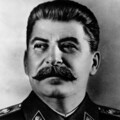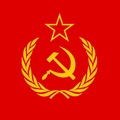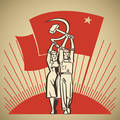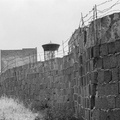Introduction for Essay
The Cold War represented a prolonged period of economic, political, military, and social conflict between the United States and the Soviet Union. This strife lasted for several decades, ending only when the Soviet Union dissolved. Triggered by mutual threats and propaganda, the Cold War led to the fear of nuclear disaster and the emergence of anti-communist sentiment in both countries.
Research Paper on the Cold War
In the political sphere, the Cold War was marked by America’s determination to prevent the spread of Soviet communism to neighboring countries. By the war’s end, American officials concurred that the most effective defense strategy was “containment,” a policy designed to curb Soviet expansion.
The social aspect of the Cold War was embodied in the Yalta Conference, the second meeting of British Prime Minister Winston Churchill, Soviet Leader Joseph Stalin, and U.S. President Franklin D. Roosevelt. During the conference, the three leaders resolved to demand Germany’s unconditional surrender.
Economically, the Cold War was manifested through the Berlin Blockade, a Soviet attempt to restrict the ability of France, Great Britain, and the United States to access their sectors of Berlin. Russia further enforced the blockade by shutting down all highways, railroads, and canals from Germany into Berlin.
In military terms, the Cold War saw the erection of the Iron Curtain, a barrier created by the Soviet Union post-World War II to isolate itself from the West and other non-communist areas.
Argumentative Essay Examples on the Cold War
Both containment and the domino theory influenced U.S. foreign policy during the Cold War, as they were integral to defense strategies and preventing the spread of communism. For example, containment served as a defensive mechanism to thwart the spread of communism to other countries, an idea underpinning the domino theory. This theory posits that if one country adopts communism, others will follow suit. The “domino effect” was suggested by President Dwight D. Eisenhower due to the concerns of hesitant U.S. ambassadors. Presidents John F. Kennedy and Lyndon B. Johnson both invoked the domino theory to justify aid to South Vietnam.
U.S. foreign policy encompasses how the country interacts with other nations and establishes standards for international entities, corporations, and its own citizens. The four primary goals of U.S. foreign policy include preserving national security, promoting world peace, securing a global environment, and maintaining a balance of power among nations.
Thesis Statement for the Cold War
The Iron Curtain served as a political and military barrier, allowing the Soviet Union to isolate itself from non-communist regions. Originating from Stalin, this curtain of control saw the installation of communist regimes in Poland, Czechoslovakia, Yugoslavia, and Albania. In a significant 1946 speech in Missouri, Winston Churchill condemned the Soviet Union’s policies in Europe, acknowledging that the region was essentially under Soviet control.
The Vietnam War and the Korean War
The Vietnam War, a struggle between the communist government of North Vietnam and South Vietnam, backed by the United States, was intensified by the Cold War. The war concluded with communist forces seizing control of South Vietnam in 1975.
The Korean War, marking the first military action of the Cold War, saw the entry of American troops in support of South Korea. It was essentially a fight against the forces of international communism. The alternative would have been a broader war involving Russia and China. The Korean War represented the initial phase of a communist campaign to seize global control.
The Warsaw Pact and Its Significance
The Warsaw Pact, also known as the Treaty of Friendship, was established on May 14, 1955, by the Polish People’s Republic. It comprised the Soviet Union, Albania, and Czechoslovakia. This pact mandated member states to assist any member attacked by an external force, leading to a united military front. This agreement was held until 1991. According to History.com, “The rise of non-communist governments in other Eastern Bloc nations, such as Poland and Czechoslovakia, throughout 1990 and 1991 marked an effective end of the power of the Warsaw Pact.”
These defense mechanisms were intrinsic to U.S. foreign policy during the Cold War because the United States aimed to prevent countries like Korea and China from endorsing communism. The goal was to create a level playing field and avoid being outmatched.
Ideas of Conditions for GRIT during the Gorbachev Years
Based on the 1960s writings of Charles Osgood, Graduated Reciprocation in Tension Reduction (GRIT) is a strategy of unilateral and risk-free initiatives showing a willingness to start and continue a process of disarmament. The goal is to reduce a conflict spiral and create a mutual trust that will make negotiations easier. GRIT begins by announcing unilateral concessions publicly and making clear intentions; a state invites reciprocation but does not demand it. GRIT continues out concessions without demanding reciprocity, and it may take several concessions in order for it to be noticed. In order for it to be considered substantial, the concessions need to be moderately costly, slowly building in its cost.
This paper will analyze the conditions that made GRIT possible during the Gorbachev years of 1985-1989 between the Soviet Union and the United States. Although the conditions of the Soviet Union during the Gorbachev years made it possible to establish GRIT, ultimately, GRIT was not the sole cause of disarmament and reduced tensions between the two countries, but instead helped aid the negotiating environment. Conditions of the Cold War In order to understand why the conditions for GRIT worked, one must understand the conditions of the Cold War that did not make de-escalation possible. Even if both decision-makers from both countries wanted to de-escalate, they could not find common ground because they were unable to accurately draw inferences about the motives and intentions of each other.
Challenges to De-escalation during the Cold War
After World War II, the large superpowers were battling for global hegemon. Mistrust stems from the security dilemma: the means a state takes to increase its own security decreases the security for others. In the context of the Cold War, this meant the proliferation of nuclear weapons. In the 1950s, the United States viewed the Soviet Union’s proposals for German reunification as devices to divide NATO, weaken the West, and encourage neutralism. Additionally, expectations can largely determine how people construe other states’ behavior, and human psychologically suggests foreign policy officials interpret another state’s actions in a way that is consistent with their pre-existing beliefs.
Mistrust is irrational but also difficult to dispel, and in the context of the Cold War, the possibility of nuclear warfare heightened fears and paranoia, making trust even more difficult to achieve. Additionally, the propaganda of both countries fueled these fears on the government and domestic levels. Mistrust was at its peak during the Cold War. A key example is said mistrust is in the 1957-1962 Khrushchev years.
Conclusion
Due to the United States’ assumptions that the Soviet Union wanted to expand its communist propaganda, the US would set unrealistic suggestions for disarmament. Secretary of State John Foster, during a National Security Council meeting, once stated, ‘Disarmament proposals are probably an operation in public relations rather than actual disarmament proposals.’ Foster’s statement helps to understand the conditions of the Cold War that made it seem unlikely for the two countries to come together to reach conditions of reduced tension and an end to the Cold War.






